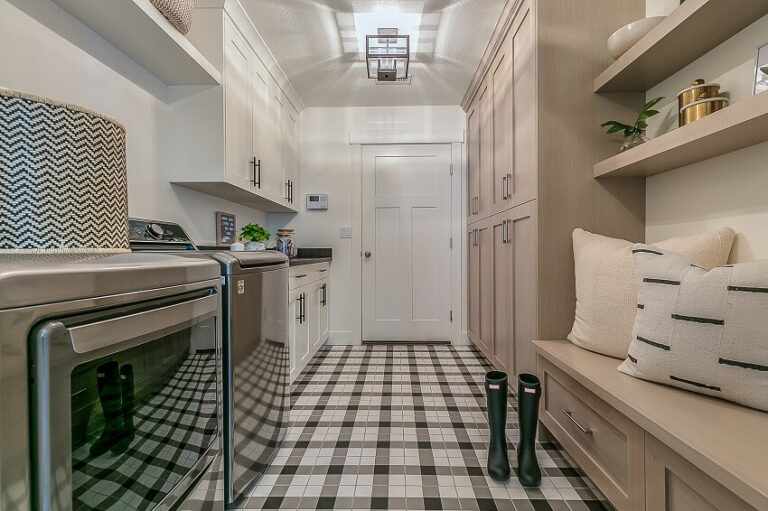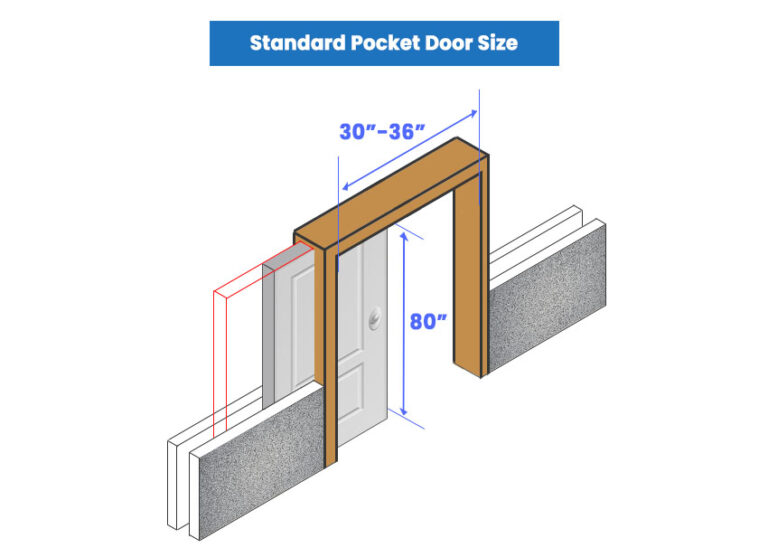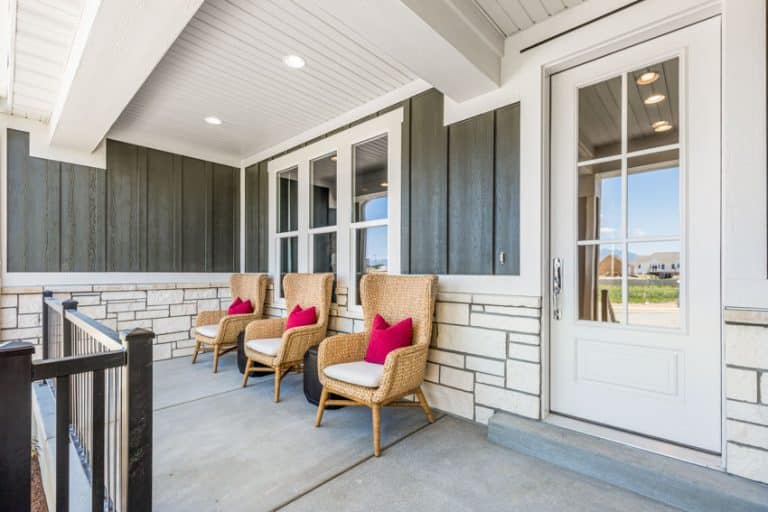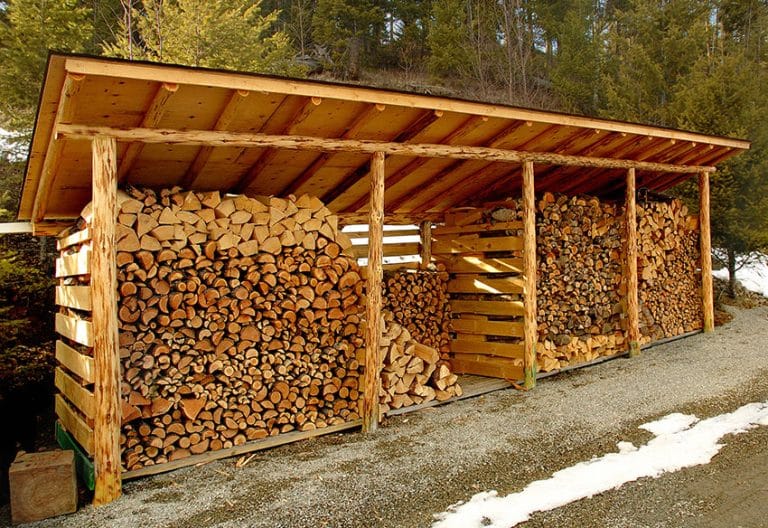8 Cost-Effective Gravel Options for Driveway Construction
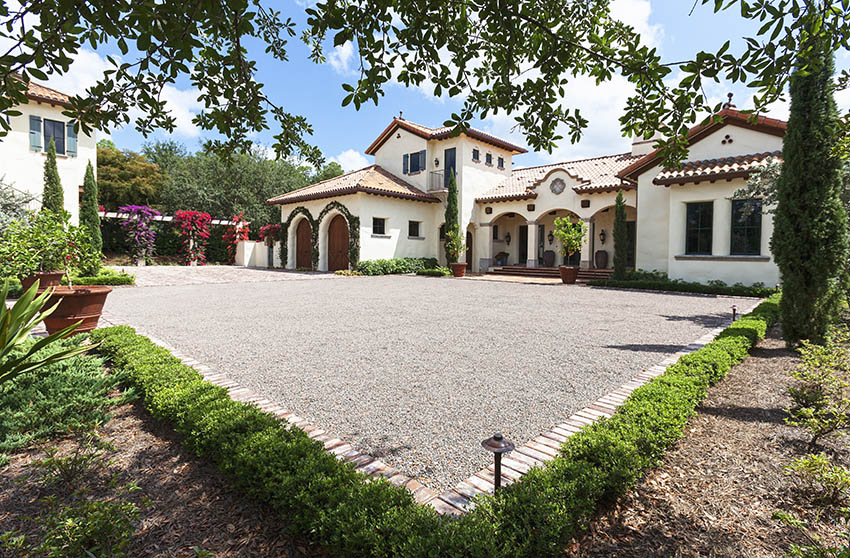
A crushed stone driveway can be an inexpensive and low-maintenance home addition that works well with many styles of homes. It’s used for driveways and roadways in many rural areas and can give a home a charming rustic feel, or modern look depending on the design.
Quicklist: The basic types of gravel driveways and their pros and cons
| Pros of Pea Gravel | Cons of Pea Gravel |
| Comes in various shades of brown, tan, and rust | Tends to shift easily |
| Highly durable and can last for many years with proper maintenance | Not suitable for slanted areas |
| Can get stuck in the soles of shoes and tire treads | |
| Pros of Marble Chips | Cons of Marble Chips |
| Stylish and practical look | One of the most expensive driveway options |
| Many options are available that can fit any kind of style | Needs a border or stabilization for a more solid surface |
| Pros of Quarry Process | Cons of Quarry Process |
| Good base layer because of a semi-permeable structure | Not aesthetically pleasing |
| More stable and doesn’t need many borders to keep it in place | Too dusty for the top layer of driveways |
| Pros of Jersey Shore Gravel | Cons of Jersey Shore Gravel |
| Highly durable and can withstand heavy weight and various weather conditions | Needs stabilization because of its round appearance |
| Resembles sand because of its color | Can be rough and uneven, which may be an issue for those with kids |
| Pros of Crushed Stone | Cons of Crushed Stone |
| Affordable | Less ideal for drainage |
| Requires barely any maintenance | Doesn’t add too much curb appeal compared to other gravel types |
| Pros of Item #4 | Cons of Item #4 |
| Offers a recycled variant made of recycled stones, concrete, and rock | Less ideal for homeowners with respiratory issues |
| Provides excellent drainage to your driveway | Only ideal as a base layer or sub-base layer |
| Pros Base Gravel #3 | Cons of Base Gravel #3 |
| Stones are large and irregularly shaped, which helps them lock into place | Doesn’t offer any wide array of variations, which makes it less appealing when used as a top layer |
| Excellent as a driveway base layer because of its texture | |
| Pros of River Rock | Cons of River Rock |
| Provides excellent drainage and makes a great edging material | More expensive compared to other gravel types used for driveways |
| Gives a unique aesthetic appeal to your property | Slippery when wet and can pose as a hazard to anyone who might walk on it |
Types of Driveway Gravel
There are many different types of driveway pebble. Many of these listed are budget-friendly and easy to install and maintain. Visit this page for additional types of driveways.
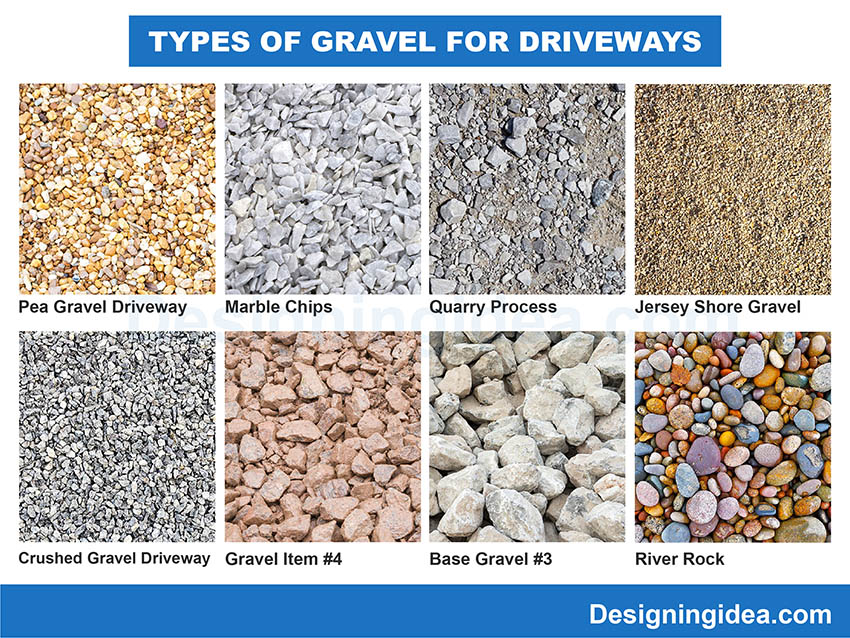
Pea Gravel
The stones that make pea gravel are small and are no larger than a pea. Some homeowners feel the stones are too smooth, and their feet or wheels sink into pea gravel more than they’d like.
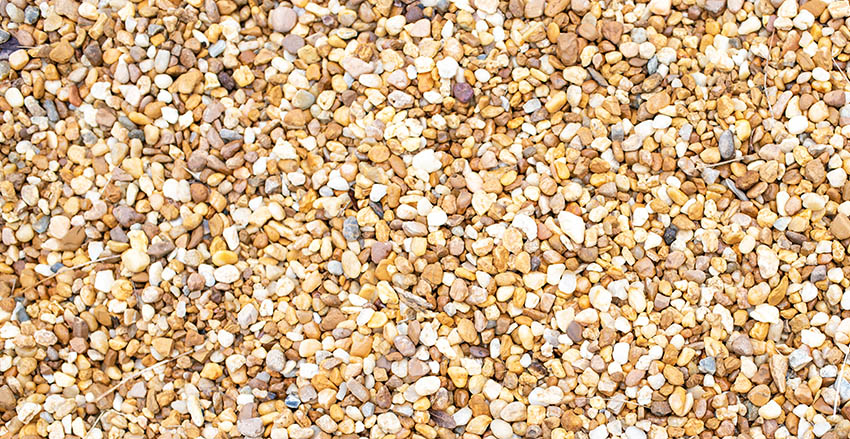
With a properly compacted base and middle layer, this shouldn’t be a problem and is mostly a matter of personal preference.
To avoid being disappointed, make sure to try out a pea pebble surface before committing to installing it in your driveway. The cost of installing pea gravel can vary between $300 to $400, depending on the location and the amount you plan to purchase.
Pros of pea pebbles:
- If you want a color other than gray, pea pebble can be a great choice since it comes in shades of brown, tan, and rust.
- Pebble stones offer a rustic look, which can fit into most design aesthetics that share similar elements.
- Pea pebble is highly durable and can last for many years with proper maintenance.
Cons of pea pebbles:
- Pea pebble shifts with every motion, creating ruts and bare areas whenever you walk or drive across it.
- Peapebble isn’t suitable for slanted areas since it will only slide off, making it slippery when you drive over it.
- The size of the pebbles only makes it easy for it to get stuck in the soles of your shoes or get caught in the tire treads.
Marble Chips
The most expensive material for the top layer of a pebble driveway is marble chips. Made from real white marble, crushed into small, squarish stones, expect to pay at least $2 per square foot.
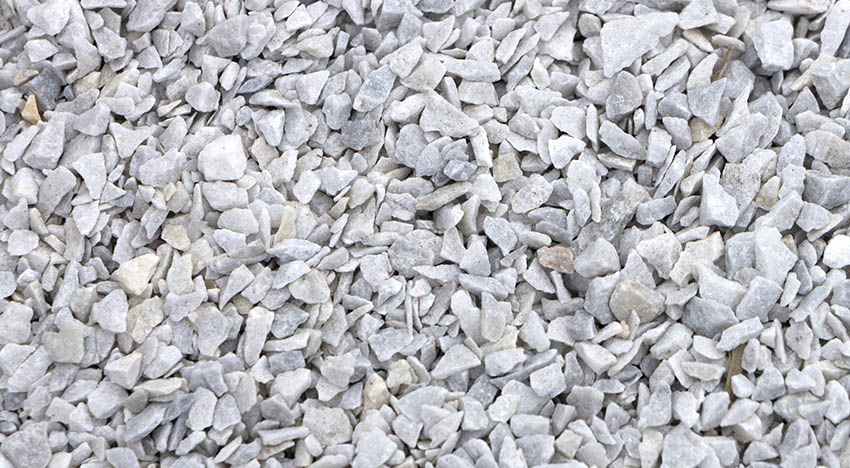
Marble chips sparkle in the morning, especially when the sunlight hits their surface. It also needs a stabilization or border to prevent it from rolling down the surface.
Pros of marble chips:
- The finished driveway will be stylish and practical and may even raise the value of your home.
- There are so many options available that can fit any style.
Cons of marble chips:
- One of the most expensive driveway options out of all the crushed stone types on the list.
- Needs a border or stabilization to create a more solid surface.
Quarry Process
Though it sounds like a verb, quarry process is actually a noun — it’s the name of an inexpensive type of crushed stone that is commonly used in driveways.
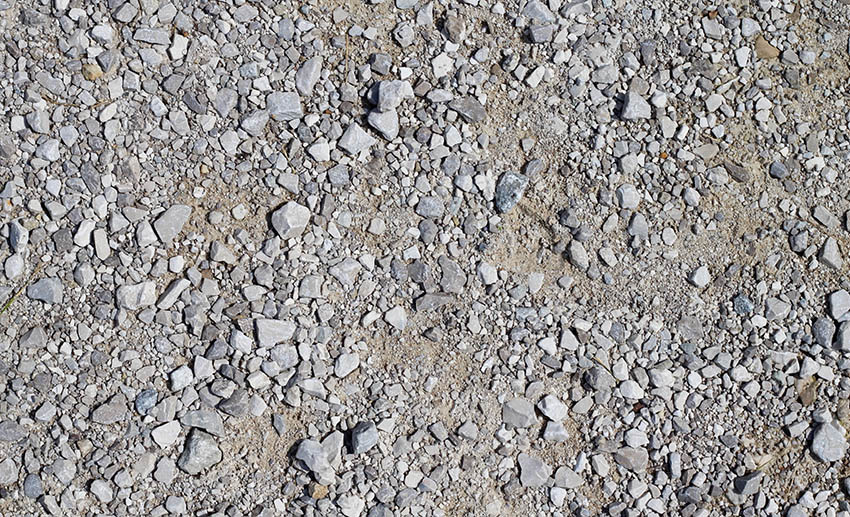
Quarry process is an ideal material for the middle layer of your crushed stone driveway because it usually has stone dust mixed in. Stone dust helps fill in the spaces between the stones, making them less likely to shift, while still allowing for appropriate drainage.
Quarry process price can range between $1 to $3 per square foot, depending on the amount you’ll need and the overall aesthetics.
Pros of quarry process:
- If you have low-lying areas of your driveway or excessively soft ground, the quarry process can fill them in before starting the installation process.
- The quarry process is a good base layer for a driveway because of its semi-permeable structure.
- It’s a lot more stable and doesn’t need many borders to keep it in place.
Cons of quarry process:
- The quarry process is never used for the top layer of driveways — it’s too dusty.
- It isn’t aesthetically pleasing compared to other crushed stone types on the list.
Jersey Shore Gravel
Jersey Shore Gravel is a specialty product only available in Northeast America. It is very popular for driveways. This yellow-colored crushed stone is available in two sizes: ¾” and ⅜” in diameter.
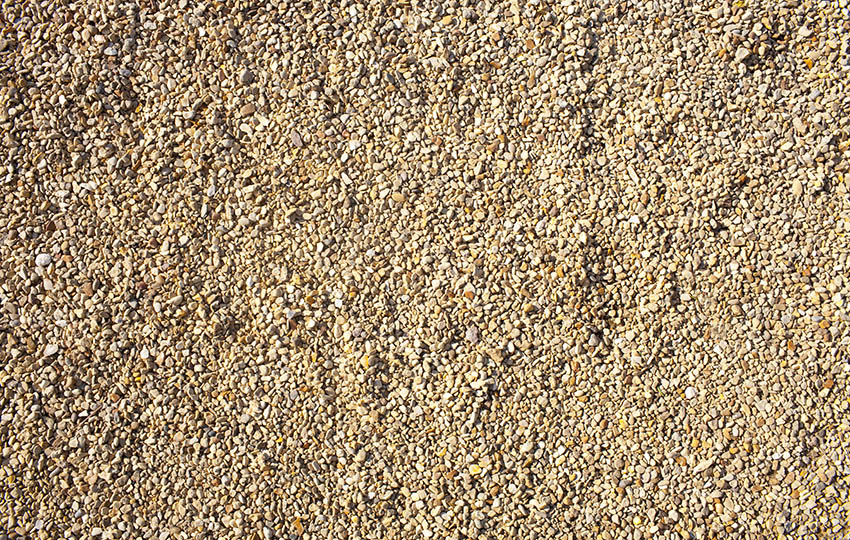
Jersey Shore gravel is one of the least expensive forms of crushed stone if you are lucky enough to live within the delivery area of a crushed stone mine. The cost for every square foot can vary between $2 to $4, including the labor and materials. If you live outside the northeast, delivery costs will likely outweigh any cost savings.
Pros of Jersey Shore gravel:
- It almost resembles sand because of its color. It can vary between tan, white, yellow, and brown.
- It’s highly durable and can withstand heavy weight and various weather conditions.
Cons of Jersey Shore gravel:
- It needs stabilization because of its round appearance.
- Since it’s a mixture of various stones, it can be rough and uneven, which may be an issue for those with kids.
Crushed Gravel
Gravel is gravel, right? Not when it’s crushed stone! But wait, isn’t all gravel just crushed rocks? That’s right — the distinction comes from how the crushing was achieved.
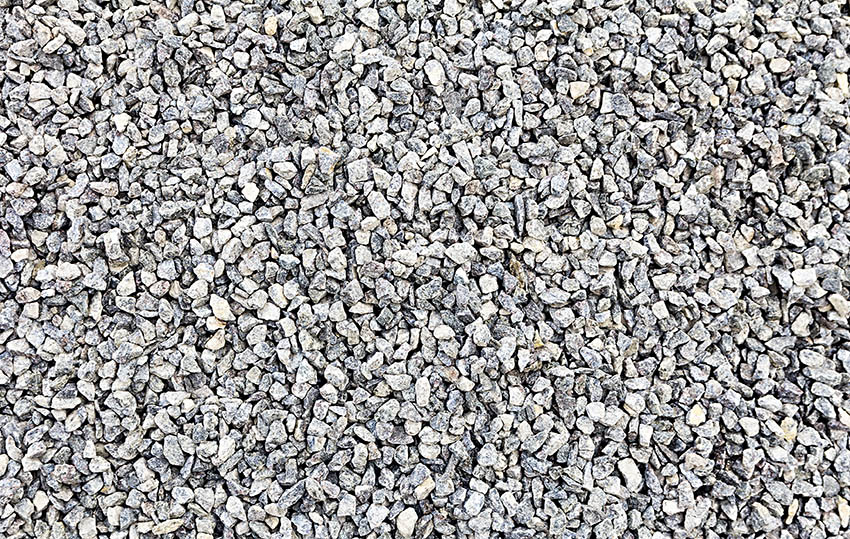
Gravel technically refers only to rocks naturally broken down by weather and/or erosion. ‘Crushed stone’ is the name given to rocks artificially broken down using heavy machinery.
“Crushed” stones or gravel have sharper edges than naturally formed aggregates and make the best bases- Popular Science
‘Real’ gravel tends to be a bit smoother than crushed stone. Depending on the project’s complexity, the cost may vary between $1 to $3 per square foot.
Pros of crushed stone:
- It’s one of the most affordable gravel types, making it an ideal choice for homeowners who are tight on their budgets.
- It requires barely any maintenance and only requires occasional re-leveling.
Cons of crushed stone:
- It’s less ideal for drainage because of its semi-permeable surface.
- It doesn’t add too much curb appeal compared to other gravel types because of its appearance.
Item #4
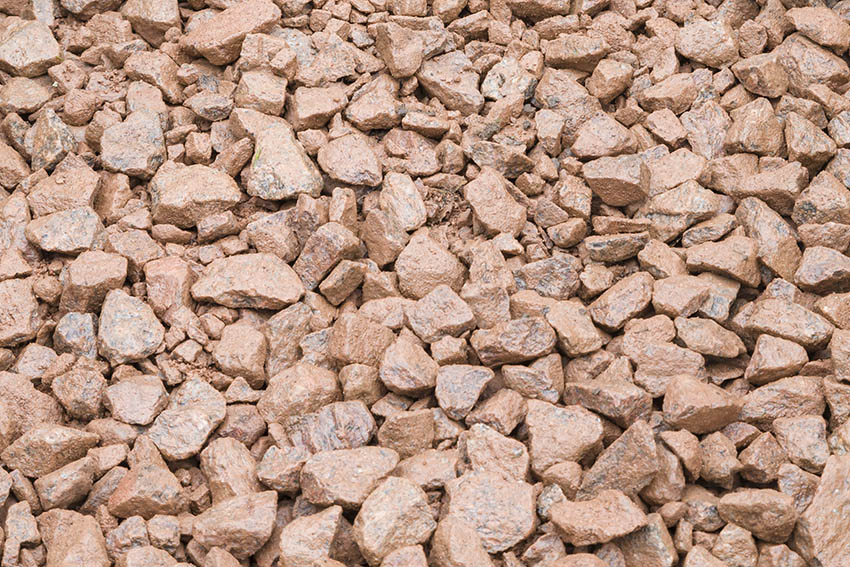
This type of gravel is well-known among driveway installers for its excellent drainage. Besides stones, the gravel also has sand, clay, and stone dust mixed in, making it more stable than stones alone.
Item #4 also makes a perfect middle layer for a gravel driveway since the stones are 1½“-2” in diameter. The gravel delivery may cost between $10 to $50 per ton, depending on how much you need.
Pros of Item #4:
- Gravel #4 offers a recycled variant made of recycled stones, concrete, and rock, making it an excellent choice for people looking for environmentally-friendly products.
- It provides excellent drainage to your driveway because of its semi-solid texture.
Cons of item #4:
- It can be less ideal for homeowners with respiratory issues because it combines dust, sand, and pulverized stone, making it only ideal as a base or sub-base layer.
Base Gravel #3 (Base Layer)
The signature quality of river rock gravel is the smooth surface of the stones. Whether gathered from a riverbed or artificially created, river rock gravel is beautiful.
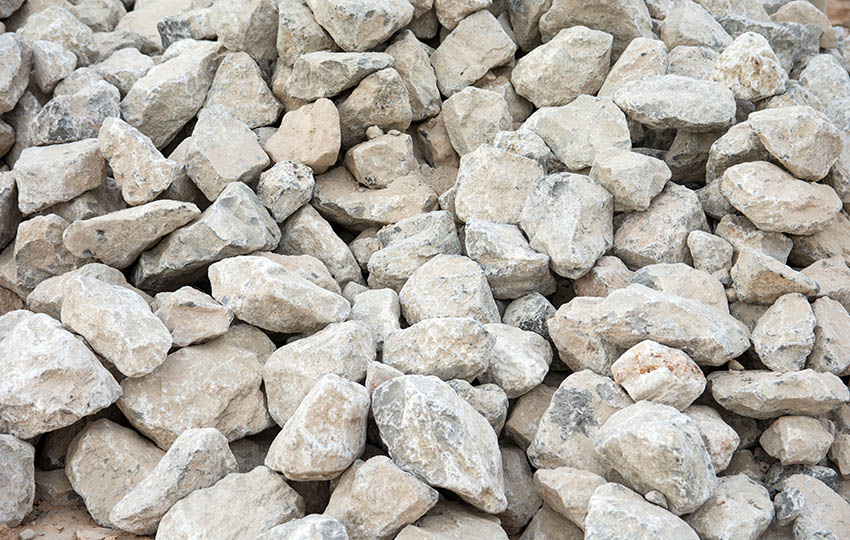
Gravel #3 is less likely to degrade, making it a practical driveway base layer option. However, its performance is still lower compared to other gravel types listed. Using base gravel #3 can cost between $0.59 to $1.50 for every square foot, depending on the project’s complexity.
Pros of base gravel #3:
- Excellent as a driveway base layer because of its texture.
- The stones are large and irregularly shaped, which helps them lock into place and minimizes shifting after installation [Source: Science Direct, Long-term Performance of Gravel Base Course Layers in Asphalt Pavements]
Cons of base gravel #3:
- It doesn’t offer any wide array of variations, which makes it less appealing when used as a top layer for your driveway.
River Rock
The signature quality of river rock gravel is the smooth surface of the stones. Whether gathered from a riverbed or artificially created, river rock gravel is beautiful.
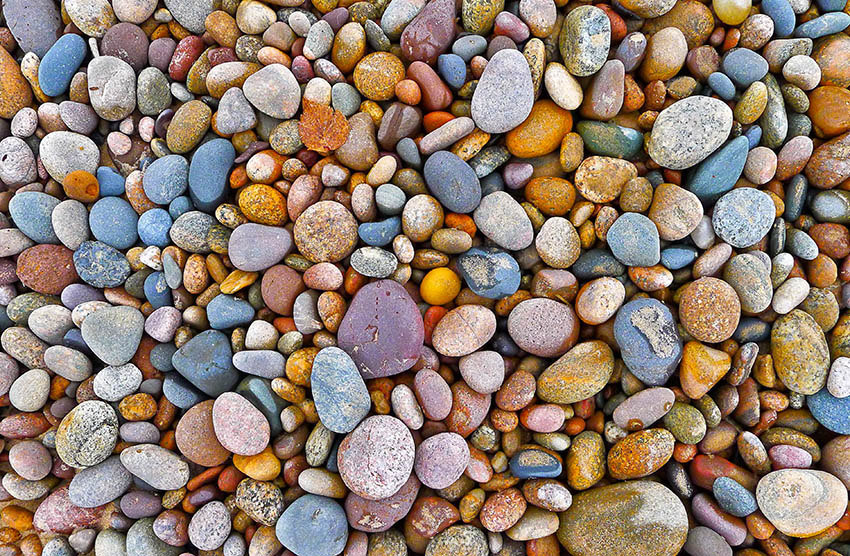
However, it is not recommended for use in driveways. The rounded, smooth stones are slippery when dry and downright hazardous when wet, and vehicles can struggle to get sufficient traction. River rock can cost between $45 to $130 per ton, depending on how much you need.
Pros of river rock:
- River rocks provide excellent drainage and make a great edging material.
- It gives a unique aesthetic appeal to your property by adding a rustic look to its overall appeal.
Cons of river rock:
- It’s more expensive compared to other gravel types used for driveways.
- Its surface tends to be slippery when wet, which can pose as a hazard to anyone who might walk on it.
Practical Tips for Choosing the Best Gravel for a Driveway
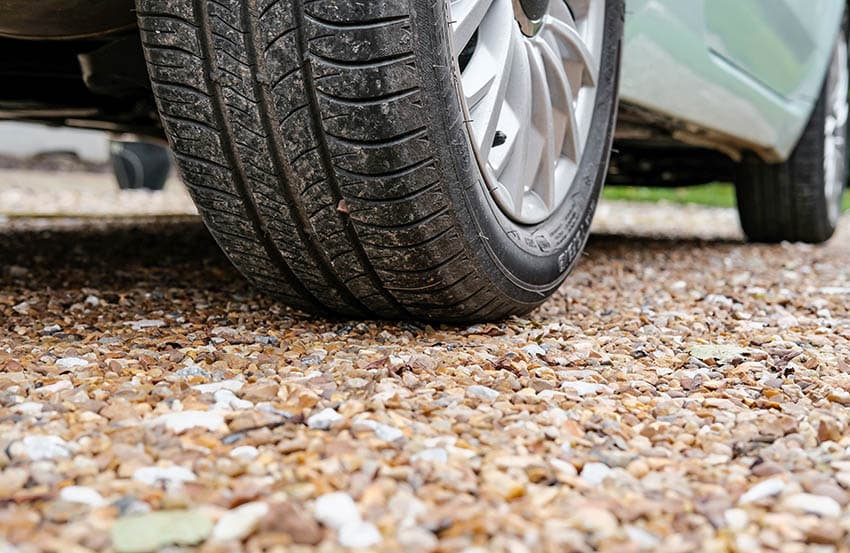
Your gravel driveway will certainly be attractive, but will it be functional as well? Yes, as long as you choose the right kind of gravel. Here are a few tips that you can consider to help you choose which type of gravel will work best for your driveway.
Consider Its Shape
Small, angular stones with rough edges make the best material for the top layer of your gravel driveway because they form a steady and stable surface.
Rounded or smooth stones are a recipe for slippage and potential injury. The two best types of gravel for a top layer are pea gravel and Jersey Shore gravel because of their shape.
Choose What Fits Your Budget
The middle and base layers won’t be seen once the project is complete, so the best gravel to use for these lower layers is whatever is most cost-effective in your area.
Reach Out to Several Suppliers
Contact several suppliers for quotes and make sure delivery is included in the quote. This is also a great time to ask if the truck will spread the gravel or drop it off.
Driveway Gravel Sizes
The top layer of a driveway should be composed of stones smaller than one inch in diameter. Larger than this, the stones will shift under uneven weight, making an unstable driving and walking surface.
The middle layer of a crushed stone driveway needs to link the smaller stones of the top layer with the larger stones of the base layer and allow for drainage.
The stones in the middle layer of a pebble driveway should be between one and three inches in diameter. The base layer should be composed of large, very rough rocks — at least two to three inches in diameter.
The Best Size Gravel for Driveways
The best size for the top layer of pebbles is smaller than 1 inch. Using crushed stone smaller than an inch is more effective than larger stones because of how compact it is. This elevated compaction highly reduces the chances of developing potholes to form over time, ensuring that the driveway surface remains even.
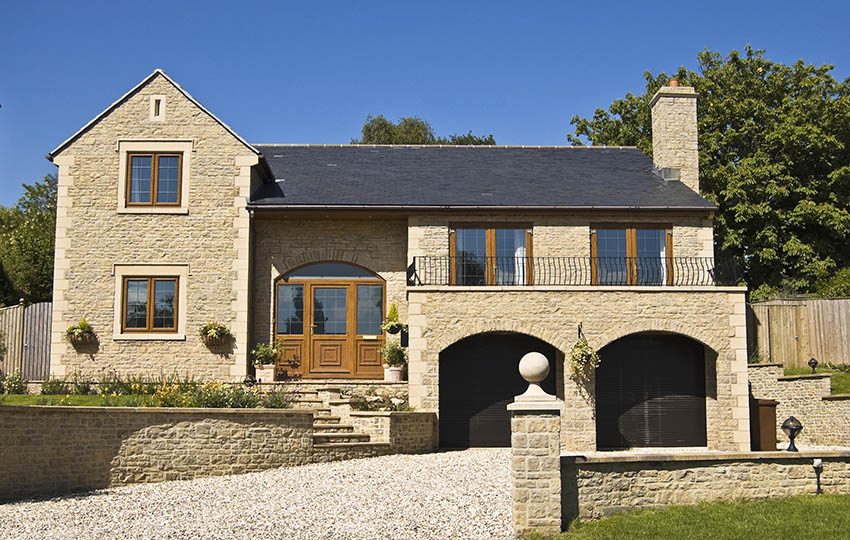
Understanding Gravel Cost for Driveways
One of the reasons crushed stone driveways are so popular is their inexpensive price tag. An asphalt driveway costs, on average, between two and four dollars per square foot.
A cement driveway is even more expensive, costing between four and six dollars per square foot. Should you decide to add finishes, details, or stains to the cement, the cost can rise to $15/per square foot.
On the other hand, crushed stone driveways are seldom more expensive than $1.80/per square foot and can sometimes be installed for as little as $1.25 per square foot.
A small, one-car crushed stone pathway of 10 feet x 20 feet should cost between $250 and $400. An average driveway, 16 x 40 feet, will cost between $800 and $1,200.
A larger two-car driveway measuring 20 feet by 60 feet should be priced at $1,500 to $2,200. If you want premium materials, such as marble chips, expect to pay a premium on top of these cost estimates.
How Much Crushed Stone for a Driveway?
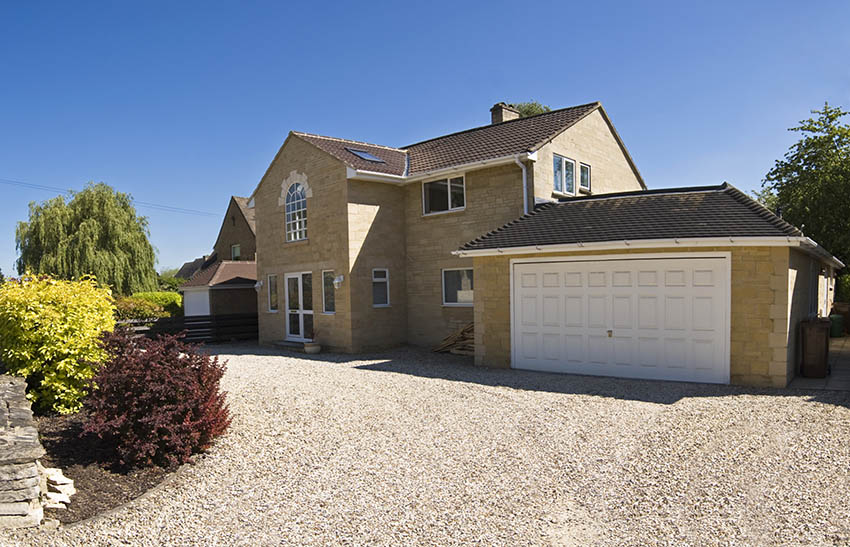
You must know its dimensions to calculate how much crushed stone you will need for your driveway. Carefully measure the length and width of the driveway.
If your driveway is curved, not straight, you may need to measure it in segments and add them together to get the total length. Multiply your width by your length to get the surface area. You can use an online calculator to figure out how much it costs.
Gravel Installation for Driveways
Step #1: Excavation is the first step in a crushed stone pathway installation. If you have an existing asphalt or cement driveway, you’ll need to jackhammer it and haul away the debris.
If you are building on a new plot or creating a driveway where there wasn’t one before, use wooden stakes and string to delineate the dimensions of the driveway.
The entire surface area of the driveway must be excavated to a depth of at least 12 inches. This can be done manually if you have the patience and the strength. If not, pay someone with a bulldozer to do it for you.
Step #2: Next, you will need a hard and level surface to get a level crushed stone pathway. A backhoe will make short work of this step, as it can level the ground and compact it.
Without a backhoe, you’ll need a tamper or a plate compactor. A tamper is a handheld tool with a long handle and a heavy plate. The plate is manually lifted and placed on soft soil, helping to compact and level it. They are inexpensive and widely available.
A plate compactor is a gas-powered machine that does the hard work of leveling and compacting for you. They can usually be rented at home improvement stores.
Compacting the soil drives the air out of it, making your crushed stone pathway less susceptible to ground-level changes during the freeze/thaw cycle.
Step #3: The third step is optional — treating for weeds. A landscape fabric barrier can be pinned down over the entire surface of the future driveway. Properly installed, landscape fabric largely inhibits (but does not completely eliminate) plant growth.
Step #4: You are finally ready for the crushed stone to arrive. You’ll need to schedule three deliveries, one for each type of crushed stone used to create a driveway.
The base layer should arrive first. Schedule the middle layer to arrive a few days later and the top layer to arrive a few days later. This will give each layer time to settle and give you some wiggle room should anything unexpected arise.
Some crushed stone suppliers will just drop off a load of crushed stone in a big pile, while others have trucks capable of spreading the crushed stone. Therefore, it’s best to inquire before ordering to determine what’s possible.
If you’re spreading the crushed stone yourself, you’ll need a metal rake, a shovel, and a wheelbarrow. After each layer, you’ll want to compress the crushed stone with a backhoe or drive a heavy vehicle over the surface.
Step #5: Once the final layer of crushed stone has been spread, it’s time for the final step of crushed stone pathway installation: crowning the driveway.
A metal rake is used to shape the top layer of crushed stone so that it’s higher in the middle, gently sloping to either side. This process should be repeated every few months to facilitate drainage.
Whenever you crown the driveway, spend some time neatening up the edges of the driveway, as smaller stones will migrate over time.
Gravel Layers
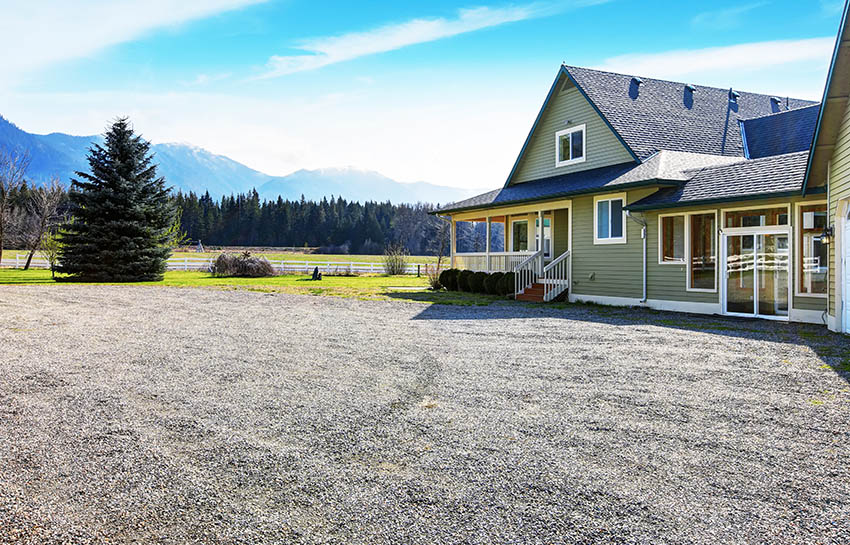
A pebble driveway has three layers. The first layer is called the base layer, and consists of large stones — about the size of baseballs.
After properly compacting, the base layer will provide a sturdy foundation for the next two layers of crushed stone. The base layer should be a minimum of four inches thick.
The next layer to go down is the middle layer. These stones will be roughly golfball size. Three or four inches of mid-size crushed stone should be sufficient to transition from the larger stones of the base layer to the finer gravel of the top layer.
Stone dust, sand, or clay dust is often added to the middle layer to help prevent the stones from shifting.
The top layer of a crushed stone pathway is the only layer that will be visible once the project is complete. Jersey Shore gravel, pea gravel, and marble chips are all popular choices for the top layer of a pebblestone patheway
DIY Driveway
Unlike asphalt or cement, almost all crushed stone pathway installation phases are DIY-able. Determination and perseverance are necessary qualities, as most phases of installing a crushed stone driveway are monotonous and physically challenging.
Getting help from a few friends or family members will make the work go much faster. Unlike many DIY projects, very few specialty tools are needed.
At minimum you should have; a strong shovel, a metal rake, a sturdy wheelbarrow (with an inflated tire), gloves, and a tamper.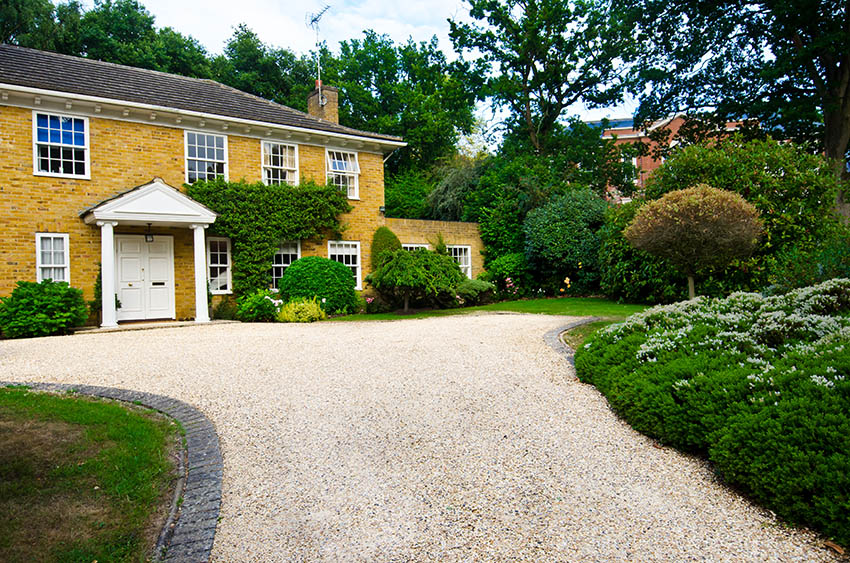
How Deep Should a Driveway Be?
Crushed stone driveways should be a minimum of 11 or 12 inches deep. The base layer and top layer must each be at least four inches deep. The middle layer can be three or four inches deep.
Excavating to a depth of 12 inches ensures that the top layer of crushed stone is flush with your lawn. Shallow excavation may cause snow and rain to move around, which, in turn, creates ruts and sinkholes over time.
Driveway Drainage
Unlike asphalt or cement, crushed stone driveways are permeable. A properly installed and maintained crushed stone driveway should have minimal issues with drainage. [Source: King County, WA: Permeable Services and Driveways]
Crowning the driveway or raking the crushed stone so it is higher at the center, facilitates proper draining and should be done every few months.
Driveway Grid
Some professionals recommend a crushed stone grid to minimize crushed stone shifting and reduce the need for regular crushed stone pathway maintenance.
Made of heavy-duty plastic, the grid is laid before the gravel, and then the stones are poured into it, helping them stay in place.
Driveway Borders
If you want to bring the level of maintenance needed down to almost nothing, consider adding a border to your crushed stone pathway.
The border can be made of any material as long as it’s solid enough to keep the crushed stone from escaping. Pavers, cobblestones, and wood are all popular borders for pebble driveways.
Driveway Hardener
Some people recommend adding a little cement to the top layer of your crushed stone pathway to harden it up and minimize dust.
It’s very easy to use too much cement and end up with a lumpy mess, so proceed cautiously. If you want a hard surface with the look of crushed stone, consider resin-bound or resin-bonded gravel.
Driveway Maintenance
Crushed rock driveways don’t need much maintenance. Cleaning up the edges by hand and raking the top layer into a rounded crown every few months should be sufficient, especially if you’ve laid down landscape fabric to inhibit plant growth.
In heavily populated areas with gravel roads, poor installation of driveways can be a problem. – Ken Skorseth, Ali A. Selim, Gravel Roads: Maintenance and Design Manual
The most important thing is to monitor the driveway and solve any problems quickly. You should periodically top up the level of crushed stone in the driveway as it settles.
You must add more crushed stones periodically depending on how often your crushed stone is used. Adding fresh crushed stone is typically done every 1 to 5 years.
It’s very easy to use too much cement and end up with a lumpy mess, so proceed cautiously. If you want a hard surface with the look of crushed stone, consider resin-bound or resin-bonded gravel.
How to Fix a Driveway Overgrown with Grass
If you’ve inherited a crushed stone pathway that hasn’t been properly maintained, your lawn may have tried to creep in. Try a natural plant killer first, like white vinegar mixed with liquid dish soap. You can move on to a chemical weed killer if that doesn’t work.
How to Fix Potholes in Driveway
An ounce of prevention is worth a pound of cure — avoid potholes by regularly crowing the driveway (raking it so it is slightly mounded in the center.)
If you catch potholes early, and only the top layer of crushed stone is involved, they can be easily fixed by raking the surrounding crushed stone back into place.
Add more gravel if necessary. If you wait, the potholes will worsen, eventually affecting the middle and bottom layers. Once this happens, you must add hardcore crushed stone (finely crushed limestone) and compact it, then spread the top layer.
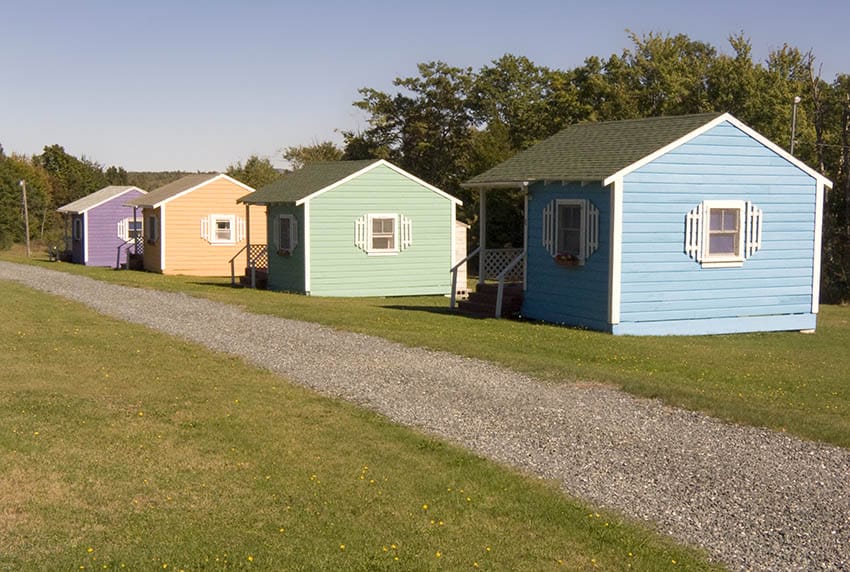
FAQs
How long do driveways made of gravel last?
A: With routine maintenance a few times a year, you can expect your crushed rock driveway to last up to 100 years. However, they will require maintenance every 1 to 2 years by adding fresh crushed stone, depending on its use.
Do I really have to level and compact the driveway?
A: Yes, unless you want a headache in a few years. Skipping this step will result in a crushed rock driveway that seems fine initially but will eventually develop potholes, puddles, and ruts.
What are the drawbacks of crushed stone type driveways?
A: Pebble driveways are not accessible to wheelchair users and may be difficult to navigate for those who use mobility aids. They can be difficult to plow since the crushed stone sticks to the snow.
What is the best type of stone for a muddy driveway?
A muddy driveway will benefit from crushed rock without sand, clay, or stone dust. The stones in the gravel should be at least 1½“ in diameter, and each stone should touch another stone. This turns mud and muck into a firm surface suitable for a driveway.
How do you keep gravel in place on the driveway?
A: Consider adding a border or edging to keep crushed rock in place on your driveway. A few inches of heavy crushed stone on either side of the driveway will help pen in the small stones of the top layer and keep them from washing away.
Which is better: Crushed Asphalt vs. Gravel?
A: The main benefit of crushed asphalt vs. crushed rock is less dust. Crushed asphalt is a recycled material, so it may be popular with eco-conscious consumers.
Now that you know the basic types of crushed rock for driveways and so much more, you’ll better understand what type to choose for your driveway. Remember that choosing the right type of driveway pebbles is essential for its longevity, functionality, and overall appearance.
By considering factors such as the weather, your budget, and your home’s aesthetics, you can finally select the best crushed stone type suited for your driveway needs. It’s always best to speak with your contractor to learn more about proper installation and maintenance to ensure it lasts several years.

